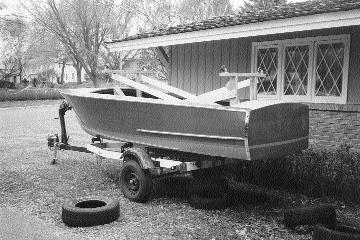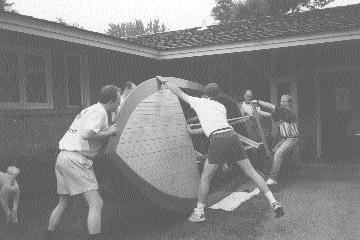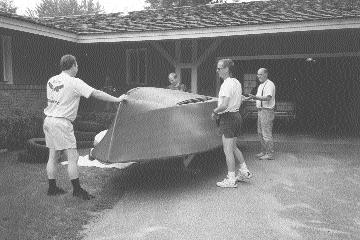by Sherwood Heggen
So! You bought that dream Chris Craft, but it needs a little attention. For sure you should look at the bottom which has faithfully given its previous six decades of owners a safe return to the docks. How long will it be before it is hanging from the lines at the dock? How much can you expect from something that was expected not to last quite this long? Isnt it time someone turned this boat over to see what kind of shape this most critical part of the boat is in? Boats dont stay afloat because of a shiny deck, you know!
 This offering of Gadgets and Kinks isnt about replacing bottoms, but how to accomplish that intimidating task of getting the boat upside down to work on it. Many ways are in use to do this job. Some involve slings and pulleys from the ceiling, hoops, cranes, fork lifts, and other clever means. For sure, if it gets the job done and it is done safely for the boat and people doing it, it is probably a good way to do it.
This offering of Gadgets and Kinks isnt about replacing bottoms, but how to accomplish that intimidating task of getting the boat upside down to work on it. Many ways are in use to do this job. Some involve slings and pulleys from the ceiling, hoops, cranes, fork lifts, and other clever means. For sure, if it gets the job done and it is done safely for the boat and people doing it, it is probably a good way to do it.
BSLOLer Fred Boss faced this task and used his smarts and friends to get the job done. His first consideration for the task was to gut the boat of everything. Then he bolted in a framework to support the boat off the floor when it was upside down. The frame work was made of 2×4s and was bolted to stringers. Diagonal bracing of 1×4s were used to make rigid the 2×4 upright supports. To diminish the strain on the stringers as the hull is rolled over, a 2×4 cross brace should be screwed to a frame on either side of the boat and also to the support frame, or the support frame should be screwed to deck beams. Fred used his head when he put castors on the bottom of the support frame for ease of moving the hull around the shop once it is turned over.
 When you are sure the support frame is secure to the hull, it is time to call up at least four friends to come over for a pizza get-together. When they get there, ask them what kind of pizza they like and call in the order for delivery. Tell them since there will be a little wait for the pizza, maybe they could come out back and help you out with a little project you have going. When they see what they are going to have to do, remind them the pizza is on you and you would appreciate a little cooperation!
When you are sure the support frame is secure to the hull, it is time to call up at least four friends to come over for a pizza get-together. When they get there, ask them what kind of pizza they like and call in the order for delivery. Tell them since there will be a little wait for the pizza, maybe they could come out back and help you out with a little project you have going. When they see what they are going to have to do, remind them the pizza is on you and you would appreciate a little cooperation!
During the process of rolling the boat over, it is important to protect the deck by placing a cushion down where the boat will contact the floor or ground. You can use folded blankets, old tires, dead cats, etc. Just be sure you place adequate cushion under the point of contact. Now have your four tentative friends stand on one side of the boat. To begin the process of the Great Rollover, instruct all four to lift together. You dont want to chance any claim filed on your homeowners policy for injury to anyones back. Your responsibility  on the other side of the boat is to give orders and to keep a watchful eye on how far they roll the boat. Once they get it almost on its side, tell them to stop and have the two end guys each shift to a new position at the stem and the transom. Here, they will balance the hull while the other two are instructed to move around to the other side of the hull. Then, have everyone unify their effort in slowly bringing the hull over center and then gently down on the support frame you worked so hard on. In those glowing after moments of this effort, you will notice the character coming out of your friends. There probably will be one who is amazed how easy the whole process was. Another guy is probably wiping the sweat from his face caused by this 30 second exertion. Dont let it get to you. This same guy probably sweats standing out in a blizzard in his shirt sleeves. The other two are now looking for that pizza reward. Well, go reward them all! It wasnt that hard of a job but it does deserve the pizza!
on the other side of the boat is to give orders and to keep a watchful eye on how far they roll the boat. Once they get it almost on its side, tell them to stop and have the two end guys each shift to a new position at the stem and the transom. Here, they will balance the hull while the other two are instructed to move around to the other side of the hull. Then, have everyone unify their effort in slowly bringing the hull over center and then gently down on the support frame you worked so hard on. In those glowing after moments of this effort, you will notice the character coming out of your friends. There probably will be one who is amazed how easy the whole process was. Another guy is probably wiping the sweat from his face caused by this 30 second exertion. Dont let it get to you. This same guy probably sweats standing out in a blizzard in his shirt sleeves. The other two are now looking for that pizza reward. Well, go reward them all! It wasnt that hard of a job but it does deserve the pizza!
A few words of caution are necessary about this process. Have an adequate number of able bodied people available. A 16-17 foot boat can easily be controlled by 5 people. As the length of the boat increases, so should the number of hands. Too many is better than to few. As the boat gets on its side, it can get tricky to control its position as its center of gravity shifts with the varying contact points on the ground. Also, as you bring it over center, be ready to experience a greater weight to control than before. This is especially true if you do not install an internal support as Fred did, but instead rest the hull on substantial sawhorses. The greater weight phenomena happens because during the first half of the rollover, the boat was being rolled like a big ball from its keel, to its chine, and up on its side. Once it is on its side, all of the weight rests on the edge of the deck and transfers over the center to those controlling it on the other side as the boat is lowered. Be ready! Thinking ahead to when the bottom is finished and you roll the boat upright again, use even greater caution! After you get the boat up on edge, the boat will have the tendency to want to roll upright like the big ball mentioned earlier – and it doesnt care who or what is in the way. Be very ready!
Thats all there is to it. The whole thing is rather anti-climactic. Now the challenge is on to make sure you restore the bottom correctly. If this task seems daunting and intimidating, then mark your calendar for March 15 from 12:30 – 5:00 to attend the workshop on restoring bottoms as instructed by Dan Nelson at Nelson Boatworks. The address is 5850 Lynwood Blvd in Mound, MN. It will help you get over the mental hump that stands in so many amateur restorers way of doing their on work. Well see you there!
Remember, dont destroy it; restore it!

